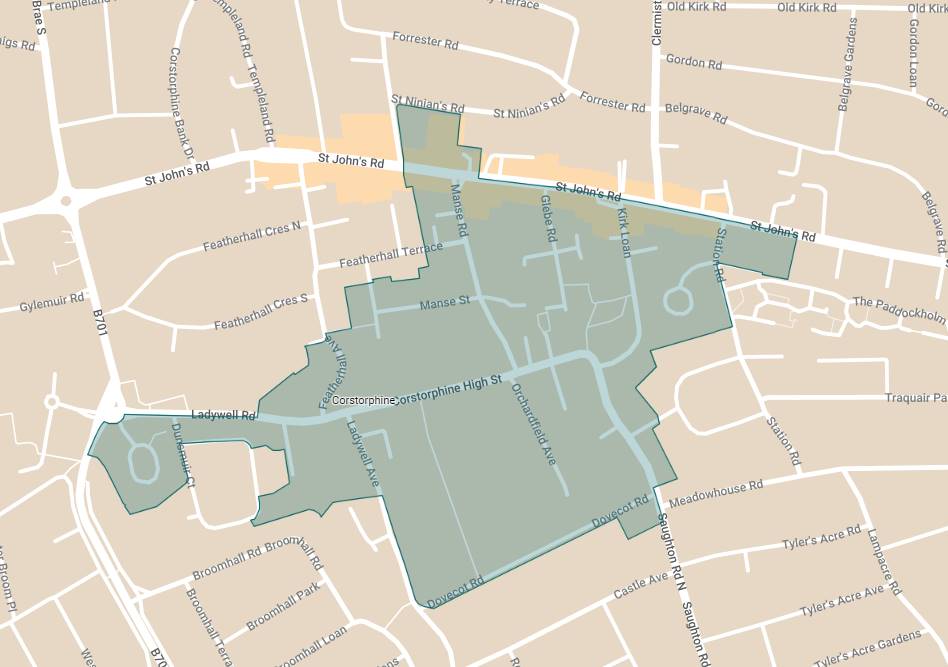City of Edinburgh Council plans
Download the weekly planning list from the City of Edinburgh Council website, and sign up to receive the weekly list direct to your inbox, via their website.
Corstorphine Conservation Area

In this area owners’ rights to develop, which would normally be allowed without having to apply for permission, have been removed and so planning consent must be sought for quite “normal” things such as changing paint colours. Within the Conservation Area permission must also be sought demolish anything. Restrictions are placed on what can be done to trees.
The Listed Buildings and Conservation Areas October 2022 Guide is for anyone considering work on a property within a conservation area or to a listed building. An excerpt from page 31 of the Corstorphine Conservation Area Character Appraisal says
“Designation as a conservation area has the following implications:
- Permitted development rights under the General Development Order are restricted. Planning permission is, therefore, required for stone cleaning, external painting, roof alterations and the formation of hard surfaces. The area of extensions to dwelling houses which may be erected without consent is also restricted to 16m2 and there are additional control over satellite dishes.
- Under Article 4 of the Town and Country Planning (General Permitted Development) (Scotland) Order 1992, the planning authority can seek approval of the Scottish Executive for Directions that restrict permitted development rights. The Directions effectively control the proliferation of relatively minor alterations to buildings in conservation areas that can cumulatively lead to erosion of character and appearance. Development is not precluded, but such alterations will require planning permission and special attention will be paid to the potential effect of proposals. The Corstorphine Conservation Area is not currently covered by an Article 4 Direction Order, and it is proposed to seek approval for restriction of the following Classes of development:
- Class 1 enlargement, improvement or other alteration of a dwelling house
- Class 3 provision or alteration of buildings or enclosures within the curtilage of a dwelling house
- Class 6 installation, alteration or replacement of satellite antennae
- Class 7 construction or alteration of gates, fences, walls or other means of enclosure
- Class 38 water undertakings
- Class 39 development by gas suppliers
- Class 40 development by electricity undertakers and
Special attention must be paid to the character and appearance of the conservation area when planning controls are being exercised. Most applications for planning permission for alterations will, therefore, be advertised for public comment and any views expressed must be taken into account when making a decision on the application.
- Buildings which are not statutorily listed can normally be demolished without approval under the Planning Regulations. Within conservation areas, the demolition of unlisted buildings requires conservation area consent.
- Alterations to windows are controlled in terms of the Council’s policy.
- Trees within conservation areas are covered by the Town and Country (Scotland) Act 1972, as amended by the Town and Country Planning (Scotland) Act 1997. The Act applies to the uprooting, felling or lopping of a tree having a diameter exceeding 75mm at a point 1.5m above ground level, and concerns the lopping of trees as much as removal. The planning authority must be given six weeks’ notice of the intention to uproot, fell or lop trees. Failure to give notice renders the person liable to the same penalties as for contravention of a Tree Preservation Order (TPO).
TPOs are used to secure the preservation of trees which are of significant stature, in sound condition, and prominently located to be of amenity value to the public at large. When assessing their contribution to amenity, the importance of trees as wildlife habitats will be taken into consideration. There is a strong presumption against any form of development or change of use of land which is likely to damage or prejudice the future long-term existence of trees covered by a TPO. The removal of trees for arboricultural reasons will not imply that the space created by their removal can be used for development.
- Grants may be available towards the repair or restoration of historic buildings The Council runs a conservation grant scheme. Such grants are normally dependent on comprehensive repair and restoration of original features and priority is given to tenement housing and prominent buildings.”
References
- Listed Buildings and Conservation Areas October 2022 Guide
- Built heritage strategy and guidance
- Managing Edinburgh’s built heritage guidance (PDF document)
- Edinburgh’s Heritage Strategy
- Guide to conservation areas in Scotland (Scottish Government publication)
- Corstorphine Conservation Area Character Appraisal
